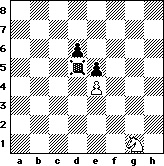
For years, I taught chess in Mercer County, New Jersey, mostly to the young boys who, with the aid of their parents, discovered the Princeton chess club. What began as just of handful of kids grew and grew in the early 1990s. Feeling that their daughters would also benefit from such instruction but concerned about a co-educational climate, a group of local parents organized a class of chess for girls. I was the instructor, and hence this story.
It was probably the first class, and I put the following diagram on the demonstration board

And so, I said: "What should you do with the knight?" You all the routine. The knight belongs in the center where the pawns can't attack it. So how to get it to the key d5-square. For years, young boys ponder the diagram and then, when picked, rush up to play Ng1-e2-c3-d5.
No difference, so far. The hands all went up, but one young girl raised her hand as high it would go and waved her hand back and forth. Such ambition should be rewarded, so I called upon her. She raced to the board and move the Ng1 straight to the d5 square. Some in the class giggled. Some of you may be too. After all, that's not how the knight moves, right? But the fact is, that's exactly the right answer! Anyone can figure out the path, but it takes understanding and vision to know exactly where the knight ought to go.
At the end of the class, I was excited and couldn't wait to get home. I called my wife.
"Cheryl, I've just discovered the difference between boys and girls."
"Oh really, you've just now discovered it?"
"I'm serious, something amazing just happened."
"Sorry. I can't talk right this second. There's something wrong with the car and I have to take it into the shop." Cheryl understood that there was a problem and she knew what had to be done. Sort of like moving the knight right to d5, eh?
"What's wrong with the car? It won't start? Tires OK? Something wrong with the engine."
To the end, a typical male. Focusing on the details rather than the big picture.